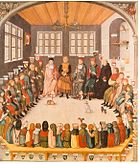List of Swabian noble families / K
K
| Surname | Headquarters | was standing | Notes on history and distribution | Membership in aristocratic associations, alliances or registers | Links to relevant picture galleries |
coat of arms |
|---|---|---|---|---|---|---|
| Kaib (from Hohenstein) | Hohenstein | Württemberg Ministerials | Branch of Speth, mentioned from 1287 to 1483 | Leitbracken | Scheibler | |
| Kaltental | Kaltental | Imperial Knight | Leitbracken Canton Kocher because of Aldingen (14th century – 1746) Mühlhausen am Neckar (until 1582) and Oßweil (until 1647) |
Scheibler | ||
| Carp ; Carp | Hohenkarpfen Castle near Hausen ob Verena and Rietheim | Imperial Knight | Family extinct in 1663 | Canton Neckar-Black Forest (1548–1663) | Sieve maker | |
| Kechler von Schwandorf | Schwandorf, district of Haiterbach 1802: Ober- and Untertalheim, and Unterschwandorf as a fiefdom of Austria |
Imperial Knights Barons |
Sankt Jörgenschild Swabian Federation Canton Neckar-Black Forest (1548–1805) (until 1748 also with the manor Diedelsheim ) |
Sieve maker | ||
| Killingen | Killingen Castle in Ellwangen - Killingen | Ministerial of the Ellwangen Monastery | mentioned from 1321 to 1428; Tribesmen of the Lords of Röhlingen, whose coat of arms they also carry |
New sieve maker |
||
| Counts of Kirchberg | Oberkirchberg | Count | Leitbracken |
 Swabian nobles as councilors Eberhard des Mild von Württemberg Graf von Kirchberg No. 41 more pictures here |
Ingeram Codex |
|
| Klingenberg | Klingenberg Castle near Homburg (Thurgau) since 1300 Hohentwiel Castle |
Ministerial of the Bishops of Constance counts |
First mentioned in 1200 in the service of the Bishops of Constance. Around 1300 important position of various members of the family as bishops in Constance, Brixen and Freising, as well as governors of various southern German cities. Co-founder of the Knights' Association from Sankt Jörgenschild. Partisans of Habsburgs in the dispute with the Confederates. Involved in various feuds in the 15th century. Gradual sale of the property. 1538 Hohentwiel was finally sold to Württemberg. 1583 Death of the last male from Klingenberger. | Leitbracken Sankt Jörgenschild : Caspar von Klingenberg († 1439) first captain of the Swabian Confederation : his grandson Caspar was killed in the Swabian War near Rielassingen in 1499 |
 Swabian nobles as counselors Eberhard des Mild von Württemberg Caspar von Klingenberg, below right (22) more pictures here |
Scheibler |
| Knöringen |
Imperial Knights Barons |
Leitbracken canton Altmühl of the knights circle Franconia (because of the rule Krießberg acquired in 1545 including Lustenau canton Kocher (1605-62) because of Wildenstein ) |
Scheibler | |||
| Chef from Gailenbach | Gailenbach Castle in Edenbergen | Imperial Knight | 1654 by Emperor Ferdinand III. ennobled and accepted into the Augsburg patriciate. Extinct in the male line in 1768. | |||
| Cook | Kocherburg in Unterkochen | Feudsmen of the Counts of Helfenstein | attested from 1136 to 1475; Then split into a Unterkochener (documented 1539) and an Oberkochener (documented 1541) line | Coat of arms of Unterkochen | ||
| Königsegg | Originally by Fronreute , they are named after Königsegg Castle near Guggenhausen from 1251 ; later Rothenfels Castle near Immenstadt in the Allgäu | Staufer Ministrale; Barons ; Count | Leitbracken |
 Leopold Wilhelm Graf von Königsegg-Rothenfels (1630–1694) Vice President of the Imperial Court Council 1665–1671 Imperial Vice Chancellor 1666–1694 more pictures here |
Scheibler | |
| Kyburg | Kyburg in the canton of Zurich | Count | Sideline of the Counts of Dillingen and the Counts of Winterthur ; the male line died out in 1263, as a result of which the Habsburg lines Kyburg-Burgdorf and Neu-Kyburg were formed through female succession . |
Individual evidence
- ↑ In most cases, coats of arms were chosen from Scheibler's book of arms (older part 1450-1480) or from Siebmacher's book of arms (1605). Both heraldic books use the term Swabia in their sorting.
- ↑ Otto von Alberti: Württembergisches Nobility and Arms Book. Kohlhammer, Stuttgart 1889–1916
- ^ The district of Reutlingen , Volume I, ISBN 3-7995-1357-4 , p. 847.
- ↑ a b c d e f Ingeram Codex: Society in the Leitbracken of Swabia
- ↑ a b c d Gerhard Köbler : Historical lexicon of the German countries. The German territories from the Middle Ages to the present. 7th, completely revised edition. CH Beck, Munich 2007, ISBN 978-3-406-54986-1 .
- ↑ in particular the bottom of the suburb of Unterschwandorf
- ↑ The Society of Sankt Jörgenschild joined the Swabian Federation in 1488 at the beginning of the first unification period . In the later unification periods, not all lower nobility genders were represented
- ↑ a b c Gustav A. Seyler: The dead Württemberg nobility (= J. Siebmacher's Wappenbuch. VI, 2). Nuremberg 1911










